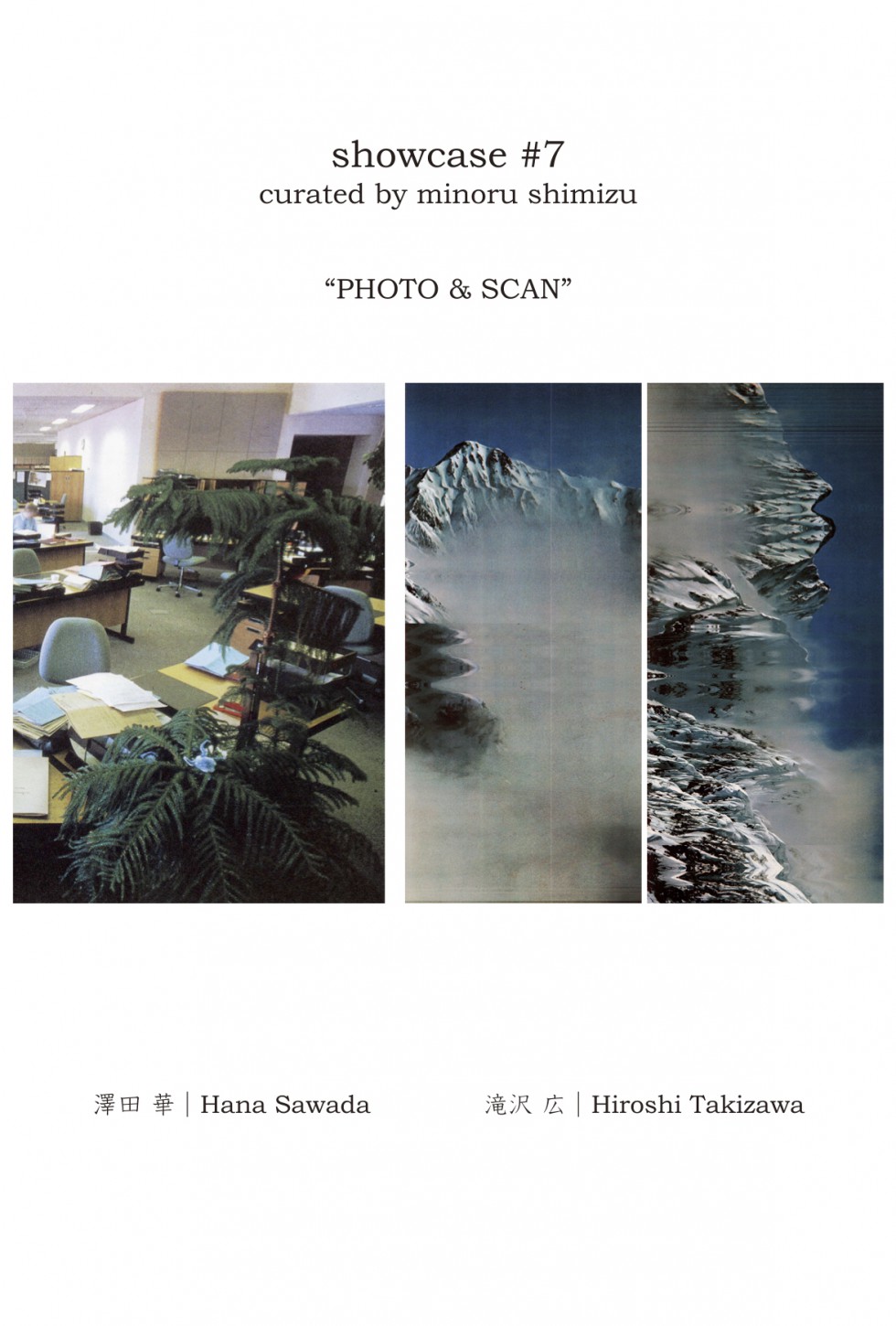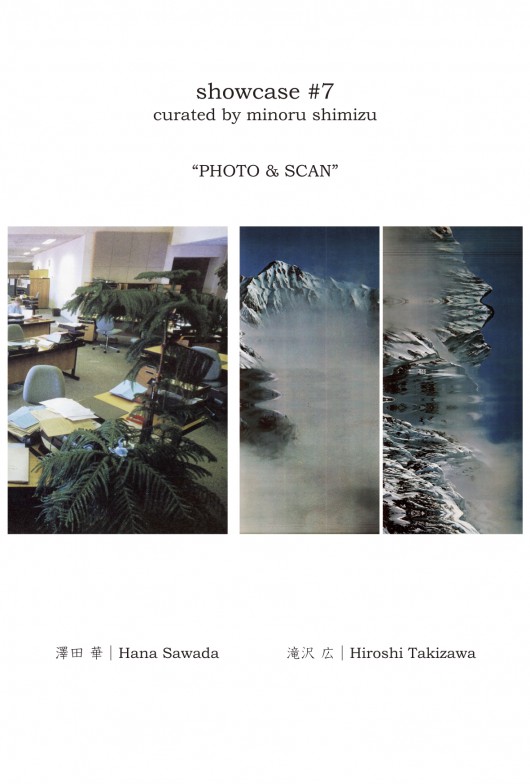Event
showcase #7 “PHOTO & SCAN”
curated by minoru shimizu
2018.05.11(fri.)— 06.11(sun.)
Hours: 12:00 ~ 18:00
Closed: Monday ~ Thursday
Admission: free
Artist:Hana Sawada, Hiroshi Takizawa
Venue
eN arts
http://www.en-arts.com/
Access:Maruyama Park, Gionmachi Kitagawa, Higashiyama-ku,
Kyoto, 605-0073, Japan
Tel: 075-525-2355
Hours: 12:00 ~ 18:00
Closed: Monday ~ Thursday
about
eN arts is pleased to present “showcase #7 -PHOTO and SCAN” curated by Minoru Shimizu, one of Japan’s leading contemporary art critics. From its inception in 2012, the “showcase” series of exhibitions, as the title implies, literally showcase talented photographers and video artists. Most of the artists selected by Minoru Shimizu for “showcase” exhibitions are the award winners of “The New Cosmos of Photography”, an annual competition held by CANON. http://global.canon/en/newcosmos/
This year, for its seventh edition, Hana Sawada (Excellence Award winner 2017) and Hiroshi Takizawa (Honorable Mention Award Winner 2011) will present a tour de force. We hope you will enjoy the show.
eN arts | Naomi Rowe
showcase #7 “PHOTO and SCAN”
In step with improvements in computing power, the digitalization in the arts started in the late 1970’s to the early 1980’s, was first fully applied in music requiring little data, and then rode the tides from physical storage devices to internet downloads and streaming before accelerating into photography and finally to video and film.
As we entered the second decade of the 21st century, digital photography stopped being the simple mimicry of analog photography. As it was based on analog photographs, what was our fundamental view of photography [basic dualisms of direct and pictorial (image processing), presence of traceability, two or three dimensional, still photos (instantly captured) and moving films (continuously captured)] is then no longer useful in the world today,
Once the composer Ryuichi Sakamoto stated that “My ears changed” as music digitalized. Music that is uploaded in a ultra pure state, entirely created within a computer, with any “noise” (sounds unwanted by the composer) is a proverbial “vacuum packed music”, untouched by air until a listener hears it played from speakers. Ears accustomed to vacuum packed music, since they are listening to the reproduction of vibrations of any type of music from the membranes of earphones or speakers, pale in comparison to the ears used to listening to live music.
In the world of images as well, the era of “Deprived Eyes”, accustomed to jpg, gif, and similar digital images, may have arrived.
In framing questions about analog photography and digital photography, comparisons of “photos” and “scans” often arise. At this point, the sense of sight employed is visual perception of an “image”. Since an image cannot be formed when the object is in close contact with the lens, some type of spatiality is necessary. A photograph is the outcome of light that is reflected or emitted from an object, passed through a lens (having the perspective of just anyone), collected on a surface, and then fixed in a photochemical process. The viewer of a photograph, places his eye at the position of the lens and then perceives the “image”. A temporal gap between “once” and “now” occurs between the between the “image” that anyone sees and the “image” that a single person sees, and reality and consciousness are separated and duplicated. Scanning, in contrast, is in principle not perception of an “image”. Rather than the spatial imaging, scanning is the recognition of intimate physical information. Even if you output a two-dimensional image, the units of that image are no longer layers but lines (or even spots – pixels, with no projected depth). Simply put, it can be said to be a vacuum-packed image.
In the world of images formed from vacuum packed images, such as jpg, gif, and the like, how do “Digital Native” contemporary artists realize “rich, expressive eyes”? How are “photos” and “scans” related to one another in world of irreversible, total digitalization?
Exhibiting artists for showcase #7 are:
Hiroshi Takizawa (b. 1983)
Honorable Mention Award in CANON’s “The New Cosmos of Photography 2011”
After having been active both domestically and abroad, Hiroshi Takizawa joins us again after five years, his second appearance since the 2013 showcase #2. The layer itself holding the image is not a material thing. Thus, in the analog world, an image is nothing but an object called film, paper, or the such. Takizawa adds fresh air to vacuum sealed images by stacking the materiality that results from “photos” and the fundamentally unlayered reality of scans. Noise appears in the image since a hand scanner is used to scan an uneven world manually. Grimacing, he then dares to photograph, print, and mount on paper the output. Noise and wrinkles are the residue of the creative act. In other words, they are the traces of the artist’s time alive (life) and body.
Hana Sawada (b. 1990)
Excellence Award in CANON’s “The New Cosmos of Photography 2017”
All the images you encounter on the internet are vacuum packed, scanned images. From this starting point, Sawada focuses on the temporal gap of a photograph as “what was it that once existed” and attempts to reverse time by using currently available digital methods to reconstitute flat, one dimensional images into three dimensional of “Former” time. But, the artist does not necessary believe in “what was it that once existed”. With a sense of skeptical playfulness, the artist exposes contemporary images completely cut off from “what was it that once existed”.
Minoru Shimizu
May 2018
Minoru Shimizu: Art Critic. Regularly contributes essays and critics for photography books, art magazines and museum catalogues. Major English publications on art: “The Art of Equivalence” in Wolfgang Tillmans truth study center (Taschen, 2005), “Shinjuku, Index” in Daido Moriyama (Editorial RM, 2007), “Fiction and Restoration of Eternity” in Hiroshi Sugimoto: Nature of Light (Izu Photo Museum/Nobara, 2009), “Daido Moriyama’s Farewell Photography in Daido Moriyama (Tate Modern, 2012), “Guardian of the Void” in Palais Magazine No.19 (Palais de Tokyo, 2014).






